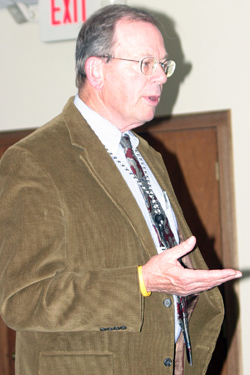 Photo by Gary DeVon
Photo by Gary DeVon
Okanogan County Superior Court Judge Jack Burchard.
” title=”394a” width=”” height=”” class=”size-FULL”>
Photo by Gary DeVon
Okanogan County Superior Court Judge Jack Burchard.
OROVILLE – Okanogan County Superior Court Judge Jack Burchard came to speak with Oroville’s Chamber of Commerce about the court’s mission, as well as the successes being seen in “Drug Court.”
“Our mission is the timely and fair resolution of legal disputes,” said Burchard. “Judges must listen carefully to all sides; think clearly and independently; decide issues based upon the law and the facts and explain their decisions promptly in understandable language,” he continued. “Every case is important.”
Okanogan County Superior Court hears 400 criminal and 700 civil cases each year, according to Burchard. Civil cases include torts, commercial, property rights, domestic violence, harassment, probate and guardianship.
The court also hears 275 family cases – these include divorce/dissolution, parenting, support, paternity and adoption. Juvenile dependents and truants add up to another 200 cases and Juvenile Delinquent cases heard each year add up to 350. Other cases such as mental illness and alcohol add another 75 for a total of 2000 cases heard each year by Okanogan County Superior Court, Burchard said.
“Former Chief Justice William Renquist said being a judge is like being a referee at a high school basketball game that has to make a call against the home team towards the end of the second half… he’s not very popular,” said the judge.
Burchard, who is running unopposed for reelection this year, said he originally thought he’d be spending most of his time on heavy criminal cases when in actuality most of his time is spent hearing domestic cases like dissolutions of marriage, domestic violence and child custody.
He went on to explain that in a criminal case those that can’t afford an attorney can have one appointed, while in a civil case there is no provision for a court-appointed attorney.
I hear thousands of cases every year and the majority of people appear without a lawyer,” said Burchard. “And you know what Shakespeare said about that…’He who represents himself has a fool for a client.'”
The judge said easements were a big problem – many relying on when the road was originally laid out by the Forest Service, county or other entity.
“Can you imagine the difficulty when one side hires an attorney? The side with the lawyer believes the court is helping the other side too much and the other side looks at the internet and believes the side with the lawyer gets too much weight at the expense of the law,” Burchard said.
Family cases take up about half the judge’s time, he said. These can include everything from adoption to truancy. While hearing an adoption case can be a pleasant experience, Burchard said truancies can be just the opposite.
“A lot of families take the attitude ‘get off our backs’ and ask why we are trying to make their kids attend school,” Burchard said. “Home-schooling is an issue. Some of the best students are home schooled, although some parents use it as an excuse not to send their kids to school.”
Judge Burchard also talked at length about the Drug Court program and how it has helped to reduce recidivism amongst those who go through the program. Drug Court is only offered to drug addicted criminal offenders who have not committed violent crimes.
“In the past the court has not done a good job… we’ve found a better way,” he said. “Drug court gets us away from the baloney and gets real.”
The judge said some of the common characteristics of addicts/alcoholics are: “They lie, they use, they resist change, they will say anything to get you off their backs, they don’t show up and they commit lots of crimes.”
“One theory is to throw them in jail and lose the key,” said the judge, who adds that the legislature has cut the time he is allowed to sentence offenders, other than meth cooks and dealers, by about 25 percent.
Studies show that sending offenders directly to prison resulted in high rates of re-arrest. In 1998 nearly 30 percent of prisoners in 15 states were rearrested within 6 months and 67 percent were rearrested within three years. If the offenders are sent to treatment alone about the same 67 percent don’t show up for intake and 90 percent drop out within the first year (of the one-third that show). Just sending someone to treatment has inadequate supervision and monitoring, he said.
Drug Court includes several people including Judge Burchard, the sheriff, a public defender, the prosecutor, the head of the narcotics task force, a probation officer and two treatment providers.
“Drug treatment can be as effective as treating a disease like diabetes, asthma or hypertension,” Burchard said, adding that the court uses science, rather than the justice system to change bad behavior.
Those that agree to go through the Drug Court program are required to have three Urinalysis (UAs) a week, attend three AA or NA meetings a week. A dirty UA or failure to take a UA results in the offender being put on the work crew.
“We used to put in jail immediately, now we put them on the county work crew pickup up trash or pulling weeds starting at 6 a.m. and working ten to 12 hours straight,” he said. “One recent high school grad who is addicted to pharmaceutical drugs said to me after being on the work crew ‘It was the worst day of my life. She was crying.”
Those in the 18 month program can also have their home searched for drugs and alcohol at any time.
“We have graduated 15 people in three years and kicked 11 out,” said Burchard. Our recidivism rate is below five percent. The 11 people that were kicked out will have a non-jury trial based on police reports… several are in prison or jail.”
When people sign up for the program they waive their rights to a jury trial and also the possibility of a plea bargain if they fail. Those that succeed also must pay full restitution to their victims.
Burchard concluded by saying, “I love my job, thanks for electing me to office.”





